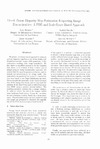Identificador persistente para citar o vincular este elemento:
https://accedacris.ulpgc.es/jspui/handle/10553/11762
| Campo DC | Valor | idioma |
|---|---|---|
| dc.contributor.author | Álvarez León, Luis Miguel | en_US |
| dc.contributor.author | Deriche, Rachid | en_US |
| dc.contributor.author | Sánchez, Javier | en_US |
| dc.contributor.author | Weickert, Joachim | en_US |
| dc.date.accessioned | 2014-05-24T02:30:45Z | |
| dc.date.accessioned | 2018-03-15T14:27:38Z | - |
| dc.date.available | 2014-05-24T02:30:45Z | |
| dc.date.available | 2018-03-15T14:27:38Z | - |
| dc.date.issued | 2002 | en_US |
| dc.identifier.uri | https://accedacris.ulpgc.es/handle/10553/11762 | - |
| dc.description.abstract | We present an energy based approach to estimate a dense disparity map from a set of two weakly calibrated stereoscopic images while preserving its discontinuities resulting from image boundaries. We first derive a simplified expression for the disparity that allows us to estimate it from a stereo pair of images using an energy minimization approach. We assume that the epipolar geometry is known, and we include this information in the energy model. Discontinuities are preserved by means of a regularization term based on the Nagel-Enkelmann operator. We investigate the associated Euler-Lagrange equation of the energy functional, and we approach the solution of the underlying partial differential equation (PDE) using a gradient descent method The resulting parabolic problem has a unique solution. In order to reduce the risk to be trapped within some irrelevant local minima during the iterations, we use a focusing strategy based on a linear scalespace. Experimental results on both synthetic and real images arere presented to illustrate the capabilities of this PDE and scale-space based method. | en_US |
| dc.language | eng | en_US |
| dc.rights | by-nc-nd | es |
| dc.source | INRIA technical repor. -- 2002. -- nº 3874 | en_US |
| dc.subject | 220990 Tratamiento digital. Imágenes | en_US |
| dc.subject | 120601 Construcción de algoritmos | en_US |
| dc.subject | 120602 Ecuaciones diferenciales | en_US |
| dc.subject | 120326 Simulación | en_US |
| dc.title | Dense disparity map estimation respecting image discontinuities | en_US |
| dc.title.alternative | a PDE and Scale-Space Based Approach | en_US |
| dc.type | info:eu-repo/semantics/article | en_US |
| dc.type | Article | en_US |
| dc.identifier.absysnet | 538131 | - |
| dc.investigacion | Ingeniería y Arquitectura | en_US |
| dc.rights.accessrights | info:eu-repo/semantics/openAccess | es |
| dc.type2 | Artículo | en_US |
| dc.utils.revision | Sí | en_US |
| dc.identifier.ulpgc | Sí | en_US |
| item.fulltext | Con texto completo | - |
| item.grantfulltext | open | - |
| crisitem.author.dept | GIR Modelos Matemáticos | - |
| crisitem.author.dept | Departamento de Informática y Sistemas | - |
| crisitem.author.dept | GIR IUCES: Centro de Tecnologías de la Imagen | - |
| crisitem.author.dept | IU de Cibernética, Empresa y Sociedad (IUCES) | - |
| crisitem.author.dept | Departamento de Informática y Sistemas | - |
| crisitem.author.orcid | 0000-0002-6953-9587 | - |
| crisitem.author.orcid | 0000-0001-8514-4350 | - |
| crisitem.author.parentorg | Departamento de Informática y Sistemas | - |
| crisitem.author.parentorg | IU de Cibernética, Empresa y Sociedad (IUCES) | - |
| crisitem.author.fullName | Álvarez León, Luis Miguel | - |
| crisitem.author.fullName | Sánchez Pérez, Javier | - |
| Colección: | Artículos | |
Visitas
62
actualizado el 11-may-2024
Descargas
38
actualizado el 11-may-2024
Google ScholarTM
Verifica
Comparte
Exporta metadatos
Los elementos en ULPGC accedaCRIS están protegidos por derechos de autor con todos los derechos reservados, a menos que se indique lo contrario.
